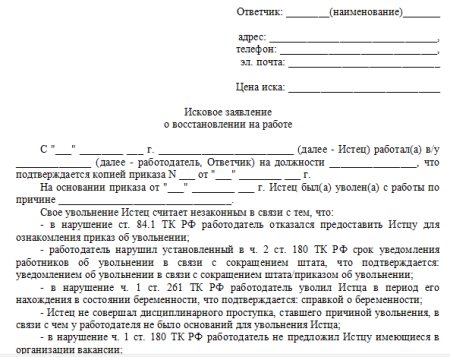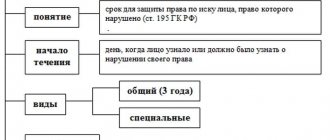Consulting lawyer › Labor law
Send
- Important points
- Grounds for restoration
- Filing a claim
- Writing a claim
- Application to the claim
- Payment after restoration
Each employee, in certain situations, may need to write a claim for reinstatement at work. This may also arise due to the simple desire of the employer to illegally fire his employee. Your rights must be protected and demanded that they be respected. Dismissal will be considered illegal when the manager cannot provide evidence of the employee’s guilt or there is no reason to do so. In this case, you will have to file and submit a claim to the court, for which you have exactly one month from the date of dismissal.
Important points
An employee has certain rights and requirements in the event that his dismissal is considered illegal. The most important thing is to recognize it as illegal by making the appropriate entries in all documents that are prescribed in the Labor Code. After this, reinstatement occurs with all the ensuing consequences for the employer. The employer can be required to pay compensation for moral damages, as well as payment of all amounts due to him due to an illegal decision. For all the time when the employee was forced to rest, the manager must pay wages.
Each of these points must be complied with by the employer, since it was he who violated them earlier. True, in certain situations it will be somewhat difficult to work in the same place after such events. But it is worth seeking justice in any case, so that this does not happen to other employees in the future.
Grounds for restoration

Every person, according to constitutional norms, has the right to work. For this reason, all problems that arise must be resolved in strict accordance with the regulations governing labor relations. Each clause of the Labor Code related to the transfer of an employee to another position or job, as well as his dismissal, must be observed.
It would be a good idea to contact a labor inspector, who can give you recommendations. They will be related to the procedure for reinstatement in case of unlawful dismissal. When you have a great desire to punish your manager and achieve justice, you should contact the labor inspectorate. Initially, the manager will be given the opportunity to pre-trially return the status to the employee and restore him to his previous place.
When the employer does not want to make any concessions, he will have to transfer all the collected documents along with the written statement of claim to the judicial authorities. And the final court decision will be the basis for the employee to be reinstated. There can be no other option here. The employer’s wishes will not play any role, since a legal decision will have to be implemented.
Restoring the statute of limitations for labor disputes
Regardless of the reason for missing the deadline, the judge does not have the right to refuse to accept the petition, and the proceedings must begin as usual. If the other party to the conflict files a counterclaim to terminate the proceedings due to the missed statute of limitations, then such a petition is granted and the case is closed.
The Civil Procedure Code establishes the grounds for reinstating the missed deadline. These include:
- disease;
- business trip;
- caring for a relative on the basis of a sick leave certificate;
- circumstances beyond the control of the employee due to which he could not prepare a claim.
To restore the lost time, you need to contact the magistrate with an appropriate petition.
Filing a claim

Before turning to the judicial authorities, you need to try various pre-trial measures. Initially, the manager is presented with your claim that the dismissal was illegal. The employer must react to it and give you a definite answer. This can be expressed in the form of a notification to the employer or an appeal to the labor inspectorate, which, based on its competence, writes the appropriate paper to the manager. The personal notice should also indicate that if the claim is denied, the employee will subsequently go to court to make a truly legal decision.
It is very important to collect documentation to attach as evidence to your application to the court. When certain difficulties arise in solving this problem, you can always turn to qualified lawyers. They will help you cope with any problem and tell you how best to act in a given situation.
It is necessary to keep under control the period during which an application can be filed with the court. As soon as the order to dismiss an employee is signed, from that day you have exactly one month to file a claim. Even if the work book is not yet in your hands, you can begin your actions to establish justice.
In response to this, quite often, the employer canceled the dismissal order or tried to formulate the grounds for dismissal differently. This is done in order to somehow justify oneself.
As for the state fee when going to court, there is a clause in the Tax and Labor Codes that when applying for illegal dismissal, employees are exempt from paying it. They will not incur any legal costs. More precisely, the defendant himself is subsequently compensated for these losses.
The court issued a decision to “Restore” - the employer’s actions
The decision to renew labor relations is subject to immediate execution (Article 396 of the Labor Code of the Russian Federation, Article 211 of the Code of Civil Procedure of the Russian Federation). No later than the next day after receiving a copy of the bailiff's decision, the employer must cancel the dismissal order and allow the employee to work.
The algorithm for restoring an employee to work is as follows.
Step 1. The employer issues an order to reinstate the employee and pay for forced absence (if necessary), indicating the invalidity of the previously adopted dismissal order.
Step 2. Introduces the employee to the order for signature. Takes all necessary measures for actual access to previous labor functions. For example: provides a workplace, issues a pass, etc. Makes a record of correcting erroneous data in the work book and personal T-2 card.
Step 3. Pays for the employee’s absence, in this case forced absenteeism. Makes changes to the working time sheet (designation code - RP) and charges the employee the average salary (if a specific amount is not indicated in the decision).
Step 4. Notifies the bailiff of the fulfillment of this order.
If the reinstated employee does not return to work, then disciplinary measures can be taken against him, including dismissal for absenteeism (Article 192.193 of the Labor Code of the Russian Federation).
Writing a claim
Thank you, your feedback is important to us
29.01.2018
★★★★★
5 5 1
“One thing can be said with complete confidence. If the head of your company fired you without any justification or at least did not bother to document them. You will be reinstated through the courts.”
- Andrey
Before contacting government agencies, it is important to draw up the document itself, namely a statement of claim for reinstatement at work. It has certain requirements that should be taken into account when writing. In this situation, you act as a plaintiff, and the head of the enterprise as a defendant. This means that the court must be provided with all complete information about the parties. Therefore, the application must contain complete information about the employee and the employer.
The main part of the document includes the following points:
- Place of work, in which organization, in which enterprise, as well as the time during which the employee held a certain position. It would not be amiss to indicate your merits, as well as the qualifications received.
- If the dismissal, in your opinion, was illegal, then it is important to write down all the points that were violated by the employer. Each of the circumstances should be sanctified separately so that everything is clear.
- It would be great if evidence of the manager’s illegal actions was also provided. This can be not only documents, but also testimony of witnesses.
- Making a request. The request is expressed not only that the employee be reinstated at his previous place of work, but also in payment for existing absenteeism that was forced. In addition, you must ask for payment of all other amounts, including moral damages.
- When there are additions to the claim, an appendix is placed indicating the number of sheets and a list of documents and information.
- At the end, the date of preparation of the document is indicated, as well as the signature of the applicant (employee).
The claim is filed in the court of the district where the organization is located. It is very important to analyze the current situation and note all the points that were violated. You need to do everything to ensure that the judge is on your side, and the leader is punished to the fullest extent of the law.
Application to the claim

It is worth dwelling a little on the appendix to the written claim. It must contain all those documents and papers that are relevant to the event in question and that will have evidentiary value. These include:
- A copy of your personal passport.
- Depending on the number of defendants in court, the same number of statements of claim must be attached in copies of the original.
- Receipt for payment of state duty. It is the defendant who must reimburse these costs to the court.
- Documents confirming the circumstances of the applicant's claims. In addition to the originals, copies must also be attached, which will subsequently be attached to the opened case file.
- Attached with the originals are also copies of evidence that there were attempts to resolve the dispute out of court. This may include notices to the employer, demands for reinstatement at work, or an appeal to the labor inspectorate.
- Copies of documents, as well as originals of calculation of the amount of claims.
In addition to these specified documents, there may be others that will have evidentiary value. The more of them there are, the more likely it is that the court will take your side when considering the claim. Here you should not be afraid of state duties and any other legal costs, since the applicant is exempt from them on the basis of labor legislation. All costs are borne by the defendant in court. It is from him that they will demand payment.
How to file a lawsuit to resolve a labor dispute
The procedure for submitting a petition for labor disputes involves the following steps:
- Determining the requirements and essence of the violation. The package of documents that will need to be prepared, as well as the list of persons who will have to be involved in the process, depend on the circumstances and grounds for sending the petition.
- Collection of documents. The evidentiary inventory of a labor dispute must contain personal documents, papers confirming employment, as well as evidence of violations.
- Establishment of jurisdiction. According to the rules of judicial proceedings, petitions must be considered at the place of residence (if a legal entity, then location) of the defendant. Magistrates' courts are authorized to consider claims only for compensation of withheld wages up to 50 thousand rubles. Otherwise, the dispute must be considered in the district court.
- Preparing an application. You can do this yourself or with the help of a lawyer. The claim must be brief, without obscene language, emotional statements or personal speculation. The number of petitions must correspond to the number of main participants in the proceedings.
- Direction of claim. This can be done in person at the court office, by mail or through a representative acting under a notarized power of attorney.
- Resolution of the dispute in essence. The duration of the procedure depends on the severity of the conflict situation.
- Making a decision. The court verdict is binding on all participants. The document enters into legal force 10 days after familiarization by the plaintiff and defendant.
- Execution of the verdict.
You can download a sample statement of claim to establish the fact of an employment relationship here.
As judicial practice shows, the successful resolution of a conflict is influenced by the list of evidence submitted, the number of witnesses involved, as well as the result of the preliminary consideration of the dispute by an internal commission. Hiring a qualified lawyer can increase the chances of a successful outcome of the case.
Payment after restoration

When a person is reinstated at work, he is entitled to payment for forced absences. The dismissal will be considered illegal. The amount should be equal to the person’s average monthly earnings during the absence, but not more than for 3 months.
In case of demotion and subsequent reinstatement to the previous place of work, the difference that the employee received less as a result of the unlawful actions of the manager must be paid. Here, too, recalculation occurs no more than 3 months in advance. All calculations must be made by accounting staff.
The manager, of course, does not spend his personal funds here, since compensation comes from the funds of the enterprise itself. But here it is worth noting that an employee, if he is illegally fired, can make claims for compensation for moral damage. In this case, all these losses must be borne by the employer himself and paid out of his own pocket.
These demands must be met immediately. If a refusal is received from the manager or he deliberately delays the payment process, then another paperwork is initiated, according to which for each day of delay, it will also be necessary to pay from the company’s account.
Dismissal may also be illegal in the event of liquidation of the enterprise. This suggests that he no longer has his previous place of work. In this case, the judicial authorities decide on the need to pay compensation to the employee. When an employee leaves his job due to layoffs, but the decision is made unlawfully, all compensation received in the event of a layoff can be taken into account by the court as compensation for forced absence.
As soon as you understand that your dismissal is illegal, you need to take action and contact your manager with a demand for reinstatement. But in case of refusal, it is necessary to write a claim and contact the judicial authorities, which are already making a legal decision. In this case, you will be paid moral damages from the manager, and you will be entitled to certain payments and compensation from the enterprise itself.
Liability for failure to comply with a court decision on restoration
Control over the execution of court decisions is entrusted to the bailiff service (Federal Law No. 229-FZ of October 2, 2007).
Penalty for failure to comply with a decision, according to Art. 7.15 part 1 of the Code of Administrative Offenses of the Russian Federation:
- for an enterprise - from 30,000 to 50,000 rubles;
- for officials - from 10,000 to 20,000 rubles.
When issuing penalties, the bailiff will set a new deadline for reinstating the employee at work. A repeated fine may occur if the employer again fails to comply with the court decision (Article 17.15, Part 2 of the Code of Administrative Offenses of the Russian Federation):
- for an enterprise - from 50,000 to 70,000 rubles;
- for officials - from 15,000 to 20,000 rubles.
For a delay in the execution of a decision, the organization additionally pays the employee the average salary for the entire period - from the day the court decision was made to the day of its actual execution (Article 396 of the Labor Code of the Russian Federation). The bailiff may discover a violation during an inspection or learn about it from an employee’s complaint.









